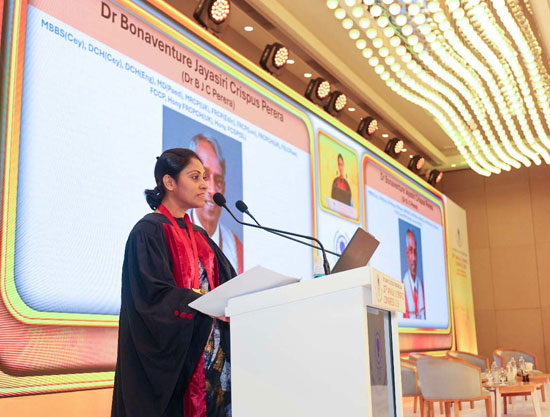Giving second life to children with liver disease
What was once an “impossible” dream is now a reality!
Made possible through a dedicated and strong multidisciplinary team, what this reality offers to the children of Sri Lanka with liver disease is hope and a second life without arduous efforts by families to collect huge sums of money to take them abroad.
It was on June 10, aptly Poson Poya, that in the prestigious Dr. B.J.C. Perera Research Prize Oration at the 27th Annual Scientific Congress of the Sri Lanka College of Paediatricians (SLCP), Dr. Meranthi Fernando of the Colombo North Centre For Liver Diseases (CNCLD), with much humility focused on the journey to save children’s lives.

Dr. Meranthi Fernando delivering the oration
Paying strong tribute to Dr. B.J.C. Perera as a “legendary” paediatrician who has magnificently uplifted childcare in Sri Lanka, Dr. Fernando, Senior Lecturer in Paediatrics, University of Kelaniya, spoke on ‘Transforming Paediatric Liver Care in Sri Lanka; establishing an era of transplantation through a dedicated Multidisciplinary Team’. It is a journey that the Sunday Times too has followed closely.
Looking at the ‘largest’ solid organ in the body, the liver, Dr. Fernando said that it can fail irreversibly due to many reasons. Once liver failure becomes medically refractory, it is cured by none other than liver transplantation.
The ‘spectrum’ of childhood liver diseases spans from self-limiting hepatitis to life-threatening liver failure due to many causes. The leading disease requiring liver transplant is biliary atresia, she said, explaining that in children, indications for liver transplant include four main disease presentations, irrespective of primary liver disease.
These indications include: End-stage chronic liver disease (cirrhosis); acute liver failure; un-resectable liver tumours without distant spread; and metabolic liver diseases. Various diseases such as biliary atresia, autoimmune liver disease and genetic metabolic diseases such as Wilson disease could give rise to these indications.
“Liver transplantation is a miraculous modality of treatment for a child with liver failure which will transform death to life within a few hours,” said Dr. Fernando. In Sri Lanka, there was no liver transplant programme for children till 2020.
Dr. Fernando said: “On July 14, 2020, a new gate opened up for paediatric health care in Sri Lanka by the achievement of the first successful paediatric liver transplant of a nine-year-old girl from Jaffna. She is now a beautiful adolescent. This resulted in significant fame and national appreciation, however, we realised that completing one transplant was not the same as establishing a sustainable programme.
“Soon after the first paediatric transplant, Sri Lanka faced the dual strain of the COVID-19 pandemic and the economic crisis. It was difficult to navigate a transplant programme amidst these crises. However, we were able to turn the negative to the positive by attracting more donations during that time, with which the programme progressed.
“Liver transplantation is essentially a multidisciplinary task which involves many specialties. In most of the liver transplant centres, it is the only dedicated job for the team. However, in the local setting we find specialists who perform this mostly amidst other duty commitments. Further with the brain drain it was challenging to retain staff. The current programme is blessed with outstanding personalities involving multiple specialties, led by Prof. Rohan Siriwardana.
“Development of para-specialities and support from the hospital administration were crucial for the programme and for its sustainability. Every team member counts whether medical, nursing or other to achieve successful outcomes. Training all the staff to do this highly specialised task was challenging, but exhibited good progress.
“We found progressing with higher numbers truly challenging with the existing infrastructure in a teaching hospital which caters to many specialities. We were fortunate to meet philanthropist M.H. Omar, who was unbelievably generous in building and equipping a dedicated liver transplant centre with state-of-the-art infrastructure resulting in the rapid growth of the number of paediatric liver transplants.
“We were able to perform 15 paediatric liver transplants in the past 12 months. The first successful paediatric liver transplant opened up the gate for many children and earned people’s trust and confidence in 2020, while the CNCLD completed its 50th liver transplant landmark the same year.
“With the advancement in modern medicine, it is possible to perform ABO incompatible liver transplants (recipients and donors having different blood types) especially in young children. This milestone in 2022 opened up a new prospect for Sri Lankan children. In late 2024, we were able to help a five-month-old baby with acute liver failure through an altruistic donor within 36 hours of referral.
“The most recent success is transplanting a child with multifocal hepatoblastoma (multiple tumours in the liver) who has shown a complete recovery along with adjunct chemotherapy.”
Underscoring the importance of a dedicated multidisciplinary team, Dr. Fernando added that the flight (paediatric liver transplantation) has just taken ground clearance. The future is to fly safely in a stable manner by keeping the team together, while meeting expectations of all parties involved including precious children and their families.
Searching for an ideal partner? Find your soul mate on Hitad.lk, Sri Lanka's favourite marriage proposals page. With Hitad.lk matrimonial advertisements you have access to thousands of ads from potential suitors who are looking for someone just like you.


